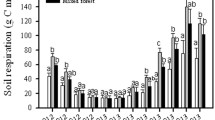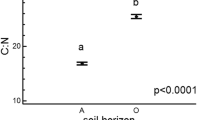Abstract
Soil respiration is CO2 evolution process from soil to atmosphere, mainly produced by soil micro-organism and plant roots. It is affected not only by biological factors (vegetation, micro-organism, etc.) and environmental factors (temperature, moisture, pH, etc.), but also more and more strongly by man-made factors. Based on literature survey, main factors affecting soil respiration were reviewed. The relationship of soil respiration to latitude and to mean annual temperature were analyzed by using the data measured from forest vegetation in the world. As a result, soil respiration rate decreased exponentially with an increase of latitude, and increased with increasing temperature. Following the relationship between soil respiration and temperature, Q10 value (law of Van Hoff) was obtained as 1.57 in the global scale.
Similar content being viewed by others
References
Albert R., 1912. Bodenuntersuchungen im Gebiete der Luneburger Heide. Zeitschrift fur Forest-and Jagdwesen. 44: 655–671. (Cited in Magnusson, 1992)
Anderson J. M., 1973. Carbon dioxide evolution from two temperate deciduous woodland soils. J. Appl. Ecol., 10: 361–378
Anderson J. O., Domsch K. H., 1975. Measurement of bacterial and fungal contributions to respiration of selected agricultural and forest soils. Can. J. Microbio., 21: 314–322.
Armentano T. V., E. S. Menges, 1986. Patterns of change in the carbon balance of organic soil-wetlands of the temperate zone. J. Ecol., 74: 755–774.
Baath E., K. Arnebrant, 1994. Growth rate and response of bacterial communities to pH in limed and ash related forest soils. Soil Biol. Biochem., 26(8): 995–1001.
Badia D. V., J. M. Alcaniz, 1993. Basal and specific microbial respiration in semiarid agricultural soils: Organic amendment and irrigation management effects. Geomicrobiology Journal, 11(3): 261–274.
Bohlen P. J., C. A. Edwards, 1995. Earthworm effects of N dynamics and soil respiration in microcosms receiving organic and in organic nutrients. Soil Bio. Biochem., 27(3): 341–348.
Bunnell F. L. et al., 1977. Microbial respiration and substrate weight loss-II: A model of influences of chemical composition. Soil Biol. Biochem., 9: 41–47.
Buyanovsky G. A. et al., 1986. Soil respiration in a winter wheat ecosystem. Soil Sci. Soc. Am. J., 50: 338–344.
Chagas C. I. et al., 1995. Tillage and cropping effects on selected properties of an argiudoll in Argentina. Communications in Soil Science and Plant Analysis, 26 (5–6): 643–655.
Chapman S. B., 1921. Aeration and Air-Contents. Publication 315. Carnegie Institution of Washington. DC. (Magnusson, 1992).
Detwiler R. P., C. A. S. Hall, 1988. Tropical foest and the global carbon cycle. Science, 239: 42–47.
Edwards N. T., 1975. Division S-7—Forest and range soils: effects of temperature and moisture on carbon dioxide evolution in a mixed deciduous forest floor. Soil Sci. Soc. Amer. Proc., 361–365.
Edwards, N. T., W. F. Harris, 1977. Carbon cycling in a mixed deciduous forest floor. Ecology, 58: 431–437.
Fang Jingyun, Liu Guohua, Xu Songling, 1996. Soil carbon pool in China and its global significance. Journal of Environmental Sciences, 8(2): 249–254.
Fang Jingyun, Wei Menghua, 1998. Carbon cycle in the arctic terrestrial ecosystems in relation to the global warming. Acta Scientiae Circumstantiae, 18(2):1–9. (in Chinese)
Farrell D. A. et al., 1966. Vapor transfer in soil due to air turbulence. Soil Sci., 102(5): 305–313.
Fernandez I. J. et al., 1993. Soil carbon dioxide characteristics under different forest types and harvest. Soil Sci. Soc. Am. J., 57: 1115–1121.
Jenkinson D. S., D. E. Adams, A. Wild, 1991. Model estimates of CO2 emissions from soil in response to global warming. Nature, 351: 304–306.
Koizumi H. et al., 1991. Effect of carbon dioxide concentration on microbial respiration in soil. Ecol. Res., 6(3): 227–232.
Kretzschmar A., J. M. Ladd, 1993. Decomposition of carbon-14 labelled plant material in soil: The influence of substrate location, soil compaction and earthworm numbers. Soil Biol. Biochem., 25(6): 803–809.
Kucera C. L., D. R. Kirkham, 1971. Soil respiration studies in tallgrass prairie in Missouri. Ecology, 52(5): 912–915.
Macfadyen A., 1970. Simple methods for measuring and maintaining the proportion of carbon dioxide in air, for use in ecological studies of soil respiration. Soil Bio. Biochem., 2: 9–18.
Macfadyen A., 1973. Inhibitory effects of carbon dioxide on microbial activity in soil. Pedobiologia, 13: 140–149.
Magnusson T., 1992. Studies of the soil atmosphere and related physical site characteristics in mineral forest soils. J. Soil Sci., 43: 767–790.
Mathes K., Th. Schriefer, 1985. Soil respiration during secondary succession influence of temperature and moisture. Soil Biol. Biochem., 17(2): 205–211.
Nakadai T., 1993. Examination of the method for measuring soil respiration in cultivated land: effect of carbon dioxide concentration on soil respiration. Ecol. Res., 8(1): 65–71.
Nakane K., 1986. Cycling of soil carbon in a Japanese red pine forest. II. Changes occurring in the first year after a clear-felling. Ecol. Res., 1: 47–18.
Nakane K., H. Tsubota, M. Yamamoto, 1984. Cycling of soil carbon in a Japanese red pine forest II. Before a clear-felling. Bot. Mag., 97: 39–60.
Neilson J. W., I. L. Pepper, 1990. Soil respiration as an index of soil aeration. Soil Sci. Soc. Am. J., 54: 428–432.
Pajari B., 1995. Soil respiration in a poor upland site of Scots pine stand subjected to elevated temperatures and atmospheric carbon concentration. Plant and Soil, 168–169 (10): 563–570.
Peterson K. M., W. D. Billings, 1975. Carbon dioxide flux from tundra soils and vegetation as related to temperature at Barrow, Alaska. Am. Mid. Nat., 94 (10): 88–94.
Qi, J., J. D. Marshell, K. g. Mattson, 1994. High soil carbon dioxide concentrations inhibit root respiration of Douglas fir. New Phytol., 128: 435–442.
Raich J. W., W. H. Schelesinger, 1992. The global carbon dioxide flux in soil respiration and its relationship to vegetation and climate. Tellus, 44B: 81–99.
Raich J. W., K. J. Nadelboffer, 1989. Belowground carbon allocation in forest ecosystems: global trends. Ecology, 70 (5): 1346–1354.
Reiners W. A., 1968. Carbon dioxide evolution from the floor of three Minnesota forests. Ecology, 49: 471–483.
Reinke J. J., D. C. Adriano, K. W. Mcleod, 1981. Effects of litter alteration on carbon dioxide from a South Carolina pine forest floor. Soil Sci. Soc. Am. J., 45: 620–623.
Russel E. J., A. Appleyard, 1915. The atmosphere of the soil: its composition and the causes of variation. J. Agri. Sci., 7: 1–48.
Saussure Th. DE., 1804. Recherches chimiques sur la. Vegetation. Paris: Gauthier-Villars. (Magnusson, 1992)
Schlentner R. E., K. V. Cleve, 1985. Relationships between CO2 evolution from soil, substrate temperature and substrate moisture in four mature forest types in interior Alaska. Can. J. For. Res., 15: 97–106.
Schlesinger W. H., 1977. Carbon balance in terrestrial detritus. Ann. Rev. Ecol. Syst., 8: 51–81.
Silvola J. et al., 1985. Effect of draining and fertilization on soil respiration at three ameliorated peatland sites. Acta For. Fenn., 191: 1–32.
Singh J. S., S. R. Gupta, 1977. Plant decomposition and soil respiration in terrestrial ecosystems. Bot. Rev., 43:449–528
Tokyo Astronomical Observatory, 1985. Year Book of Science. Tokyo: Maruzen Press. (In Japanese)
Wiant H. V., 1967. Influence of temperature on the rate of soil respiration. J. Forest, 65: 489–490.
Wildung R. E., 1978. The interdependent effects of soil temperature and water content on soil respiration rate and plant root decomposition and arid grassland soils. Soil Biol. Biochem., 7: 373–378.
Witkamp M., M. L. Frank, 1969. Evolution of CO2 from litter, humus and subsoil of a pine stand. Pedobiologia, 9: 358–365.
Author information
Authors and Affiliations
Additional information
This project was supported by National Natural Science Foundation of China to FJY (No. 3940003).
Rights and permissions
About this article
Cite this article
Fang, J., Zhao, K. & Liu, S. Factors affecting soil respiration in reference with temperature’s role in the global scale. Chin. Geograph.Sc. 8, 246–255 (1998). https://doi.org/10.1007/s11769-997-0018-9
Received:
Issue Date:
DOI: https://doi.org/10.1007/s11769-997-0018-9




